*NURSING > STUDY GUIDE > HESI Review - Lecture notes All Chapters Nursing Care of Psychiatric Clients (All)
HESI Review - Lecture notes All Chapters Nursing Care of Psychiatric Clients
Document Content and Description Below
• Subjective emotional response to a stressor. • Biochemical—abnormal elevation of blood lactate. • Neurochemical—Elevated levels of norepinephrine. • Medical conditions—abnormal hypo... thalamic-pituitary-adrenal or thyroid axis, MI, substance intoxication withdrawal, hypoglycemia, caffeine intoxication, mitral valve prolapse. CRITERIA FOR DIAGNOSIS: 1. Excessive anxiety and worry about a number of events that the individual finds difficult to control. 2. Restlessness or constantly feeling on the edge. 3. Easily fatigued. 4. Difficulty concentrating. 5. Easily irritated. 6. Muscle tension. 7. Sleep disturbance: Difficulty falling or staying asleep; or restless unsatisfactory sleep. FYI GENERALIZED ANXIETY DISORDER: Chronic unrealistic, excessive anxiety and worry—lasting six (6) months or longer Psychodynamic theory—egos can’t intervene when conflict occurs between ego and super ego Cognitive theory—disturbance of coping mechanism due to distorted thinking. Usually a dysfunction of the information processing Biochemical theory—abnormal elevation of blood lactate Neurochemical theory—Excess norepinephrine PHOBIAS: Fear of being in places or situations from which escape might be difficult or in which help might not be available. May develop from modeling behavior or self taught (Ex: mother with a exaggerated fear transfers this to a child) Cognitive theory— External locus of control—stressor—>anxiety—>attributed to external source —>phobia Internal locus of control—stressor—>anxiety—>anxiety is attributed to the stressor—>problem solving Biological –tendency one is born with—tendency must be reinforced in life— Ex: child has fear of big dogs—overcome it OR if bitten—becomes a phobia Social Phobia—situation when person might do something embarrassing or be negatively viewed by others. Usual onset 20-30 years of age Psychoanalytical theory—Ex: child raped by adult on a boat. In adult years transfers the fear onto the boat and develops an aversion to getting on a boat. OBSESSIVE COMPULSIVE DISORDER Unwanted, intrusive ideas, thoughts, impulses, or images that cause marked anxiety or distress MOST COMMON—fear of contamination, repeated doubts, things must be in a particular order, aggressive or horrific impulse, and sexual imagery Psychological theory—weak, underdeveloped egos Learning theory—conditioned response to a traumatic event—avoidance--- ACTION OF THE MEDICATIONS: Benzodiazepine (BZ) binds to the GABA receptor–reduces the number of areas of receptor sites, thus reducing anxiety. COMMONLY PRESCRIBED MEDICATIONS Ambien (Zolpidem Tartrate) Klonopin (Clonazepam) Atarax, Vistaril (Hydroxzine) Librium (Chlordiazepoxide) Ativan (Lorazapam) Luminal (Phenobarbital) Benedryl (Diphenhydramine) Prosom (Estazolam) Buspar (Buspirone) Restoril (Temazepam) Halcion (Triazolam) Valium (Diazepam) Xanax (Alprazolam) POSSIBLE SIDE EFFECTS: • With chronic use someone can develop a dependency. • Contraindicated in clients with hepatic dysfunction, renal impairment, or someone who has a previous drug addiction. • Mental confusion—call your doctor immediately • Hallucination— • Skin rash or itching • Sore throat and fever • Unusual excitement, overly nervous, overly irritable, or trouble sleeping Kneisl, C. R., & Trigoboff, E. (2009). Contemporary Psychiatric-Mental Health Nursing. New Jersey, Pearson Prentice Hall. Townsend, M. C. (2002). Essentials of Psychiatric Mental Health Nursing (2nd ed). Philadelphia, F. A. Davis Townsend, M. C. (2009). Psychiatric Mental Health Nursing. Concepts of Care in Evidence-Based Practice. (6th ed.). Philadelphia, F. A. Davis. OTHER POSSIBLE SIDE EFFECTS AND NURSING IMPLICATIONS • Use caution if pregnant, lactation, and children (still unproven with children)-- benadryl • Blurred vision or other changes in vision—DO NOT drive until your vision improves and you see clearly • Clumsiness—Caution to move slowly--should subside in two weeks • Dizziness—Avoid driving or activity that requires alertness until response to the medication is known • Slurred speech—Assess during clinic visit—should subside in approximately two weeks • Mental confusion-Assess during clinic visit • Hallucination—Monitor—contact physician if it persists • Skin rash—Monitor—contact physician if it persists • Sort throat and fever—Monitor—contact physician if it persists • Easily irritated—Monitor—contact physician if it persists • Dry mouth—Good oral hygiene, frequent sips of water, sugarless gum or candy— should subside in approximately two weeks. • Constipation—Increase fluid intake (water, juice—non carbonated beverages) high fiber diet, walk/increase physical activity if possible • Dependence—Monitor for increased tolerance to med • Liver complications—Monitor liver function tests, AST, ALT serum bilirubin • Caution if taking med with antidepressants, antihistamines, other benzodiazepines • May decrease efficacy of levodopa • KLONOPIN—avoid chamomile tea, valerian, kava, hops or skullcap natural meds PATHOPHYSIOLOGY OF DEPRESSION • Genetic: Tendency to run in families. Client is more likely to develop depression if a close family member has a history of depression. • Biological: May be caused by a chemical imbalance (decreased amounts) of serotonin, norepinephrine and dopamine. • Harmonal: May be associated with pre OR post- menstrual cycle due to changing estrogen or progesterone serum amounts. • Medication Side Effects: May be a side effect from using steroids, cancer chemotherapy or antiparkinsonian agents CRITERIA FOR DIAGNOSIS: ACTION OF THE MEDICATIONS • Increase the concentration of norepinephrine, serotonin, and/or dopamine in the body. • Selective serotonin reuptake inhbitor (SSRI’s): Block the reuptake of these neurotransmitters by the neurons. Kneisl, C. R., & Trigoboff, E. (2009). Contemporary Psychiatric-Mental Health Nursing. New Jersey, Pearson Prentice Hall. Townsend, M. C. (2002). Essentials of Psychiatric Mental Health Nursing (2nd ed). Philadelphia, F. A. Davis Townsend, M. C. (2009). Psychiatric Mental Health Nursing. Concepts of Care in Evidence-Based Practice. (6th ed.). Philadelphia, F. A. Davis. • MAOI’s block the enzyme monamine oxidase. The MAOI deactivates (inhibits) norepinephrine, serotonin and dopamine. COMMONLY PRESCRIBED MEDICATIONS (* = MHMR clinic samples) *Celexa (Citalopram) Paxil (Paroketine) Cymbalta *Prozac (Fluxetine) Deseryl (Trazadone) *Remeron (Mirtazapin) *Effexor (Venlafaxine HCL) *Serzone (Nefazondone) *Lexapro (Escitalapram) *Wellbutrin XL (Bupropion) Luvox (Fluvoxamine) *Zoloft (Sertraline) POSSIBLE SIDE EFFECTS Instruct your client to monitor his/her signs and symptoms closely and call his/her doctor immediately if he/she develops: • Skin rash • Seizures, fine muscle tremors, inability to sit still • Anxiety, nervousness, agitation or trouble falling asleep • Irregular heartbeat • Weight loss and diminished appetite • Difficulty breathing or swallowing • Fever OTHER POSSIBLE SIDE EFFECTS AND NURSING IMPLICATIONS • Prozac—Clients may NOT take this medicine with MAO inhibitors (Nardin, parnate) • Drowsiness • Dry mouth-Instruct client to use sugarless candy, ice, frequent sips of water • Sedation-Ask for med at bedtime, decrease the dosage, instruct the client NOT to drive or use dangerous equipment when feeling sedated • Nausea-take med with food to minimize GI distress Tricyclics or heterocyclics: • Blurred vision—Should subside after a few weeks. Instruct the client NOT to drive until vision is clear. • Constipation-Eat foods high in fiber, increase fluid intake & exercise if possible. • Urinary retention-report this to your physician, monitor input and output. • Orthostatic hypotenstion-instruct client to rise slowly from lying of sitting position, check BP. Avoid long, hot showers or baths. • Tachycardia-monitor BP, pulse • Photosensitivity—Instruct client to wear protective sunscreens, clothing and sunglasses when outdoors • Weight gain-Instruct client on a reduced caloric diet, encourage client to increase physical activity • Trazadone—Priapism-prolonged penile erection, withhold med, notify physician immediately [Show More]
Last updated: 2 years ago
Preview 1 out of 11 pages
.png)
Buy this document to get the full access instantly
Instant Download Access after purchase
Buy NowInstant download
We Accept:

Reviews( 0 )
$7.50
Can't find what you want? Try our AI powered Search
Document information
Connected school, study & course
About the document
Uploaded On
Jun 01, 2021
Number of pages
11
Written in
Additional information
This document has been written for:
Uploaded
Jun 01, 2021
Downloads
0
Views
120



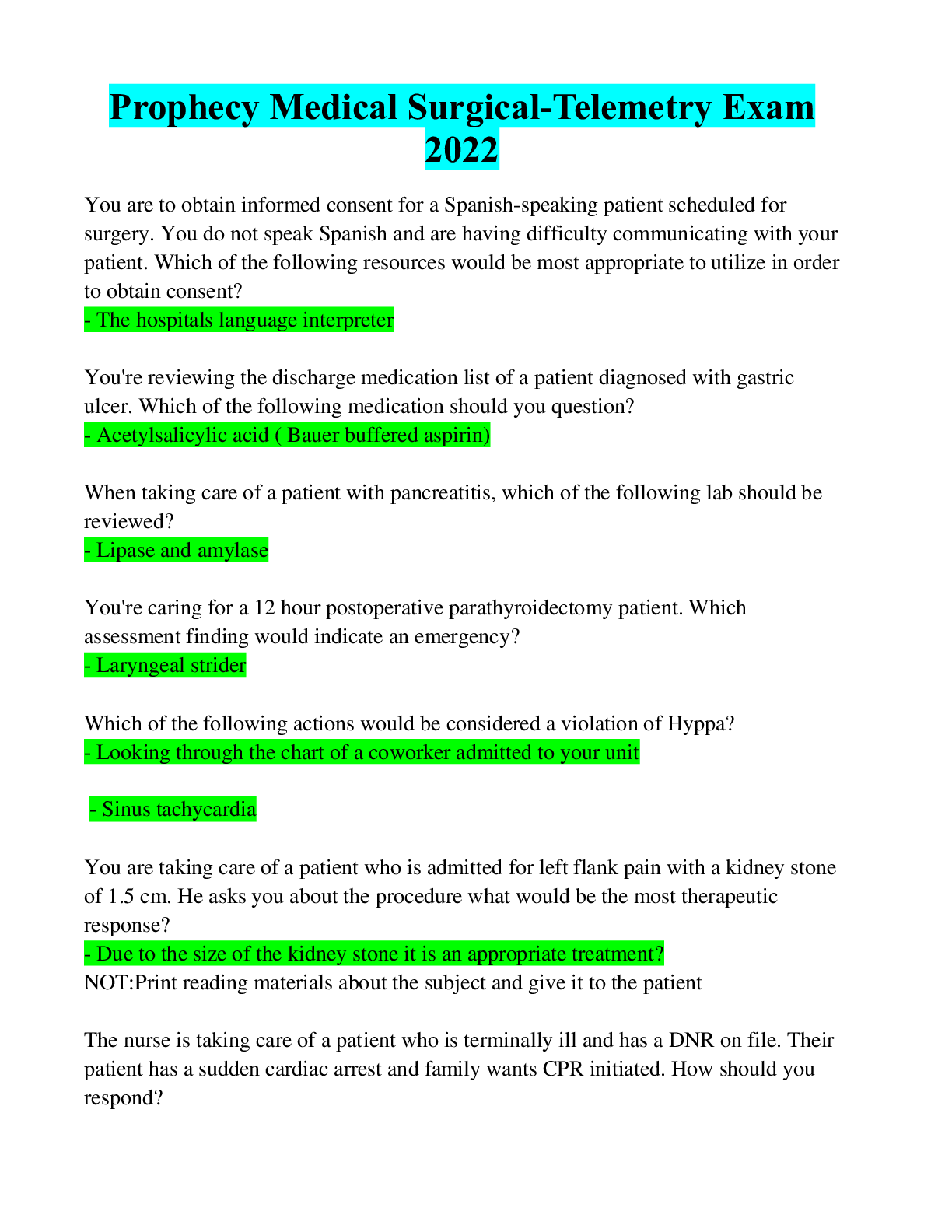


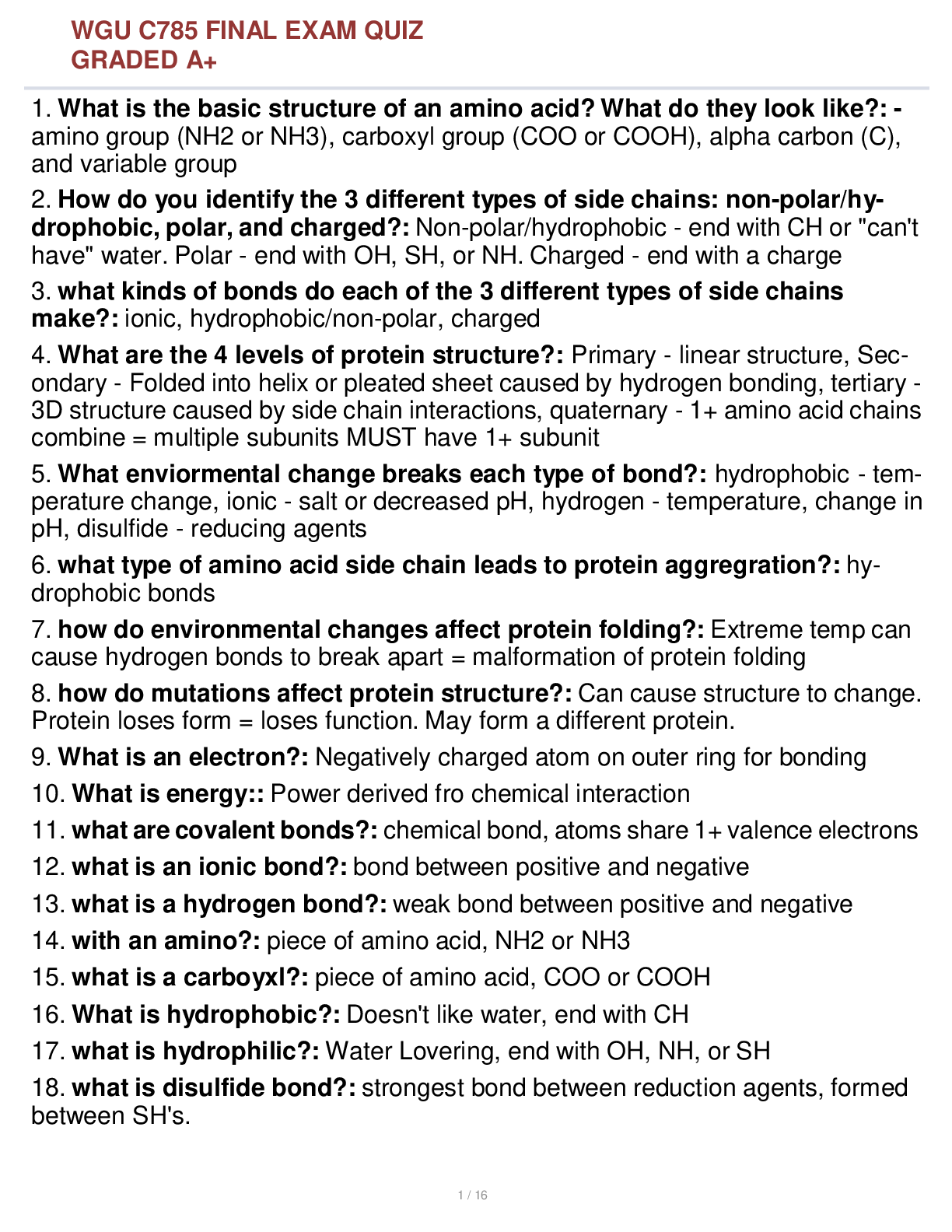
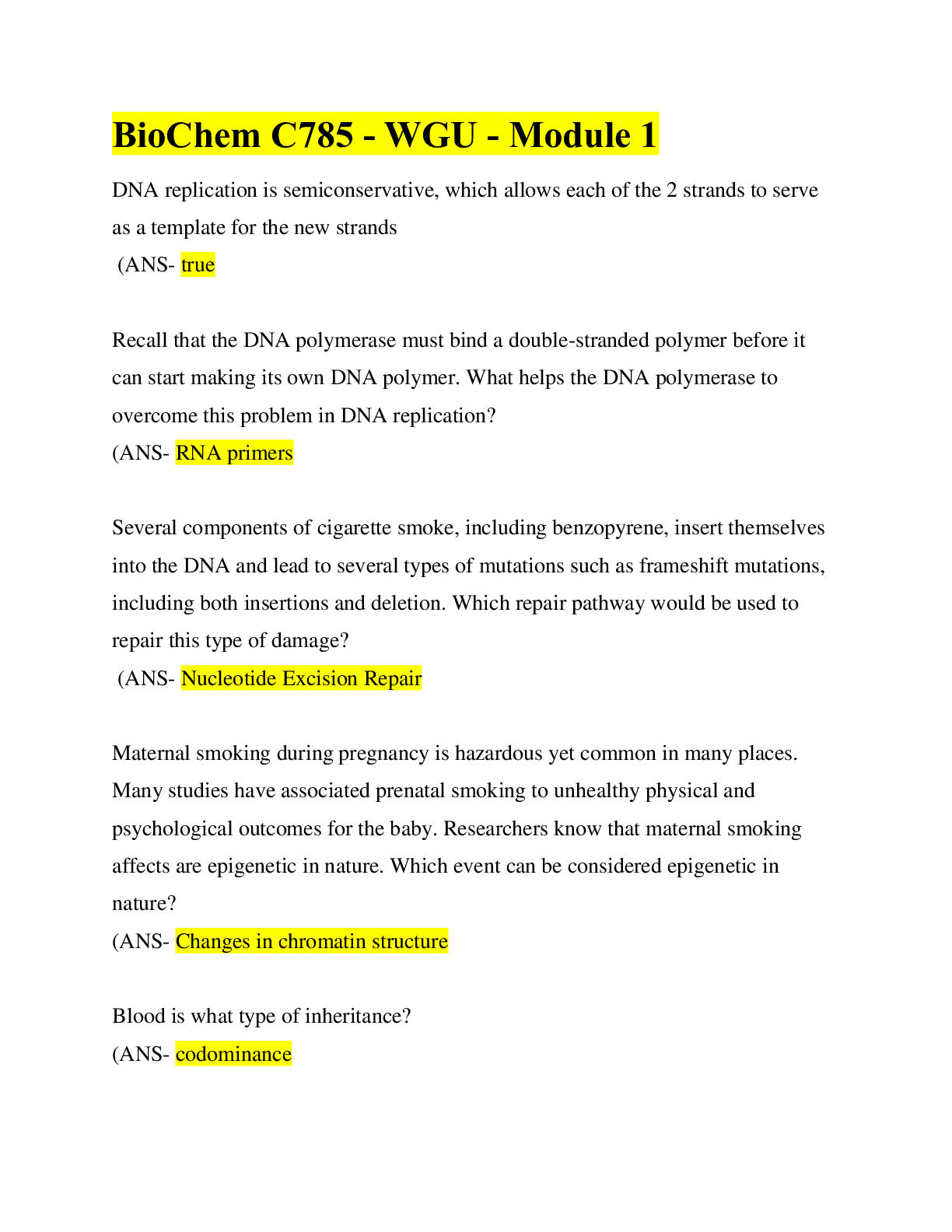
.png)
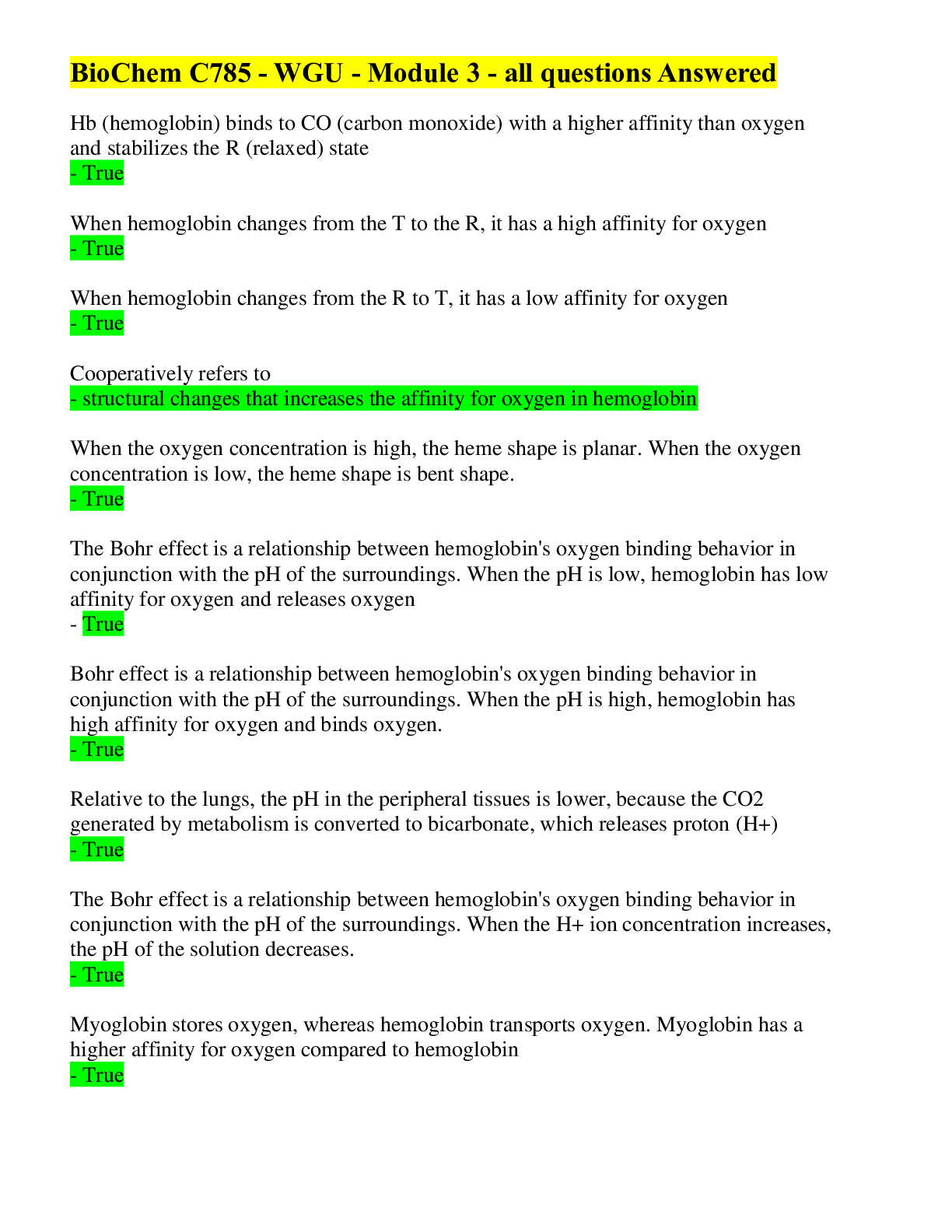
.png)
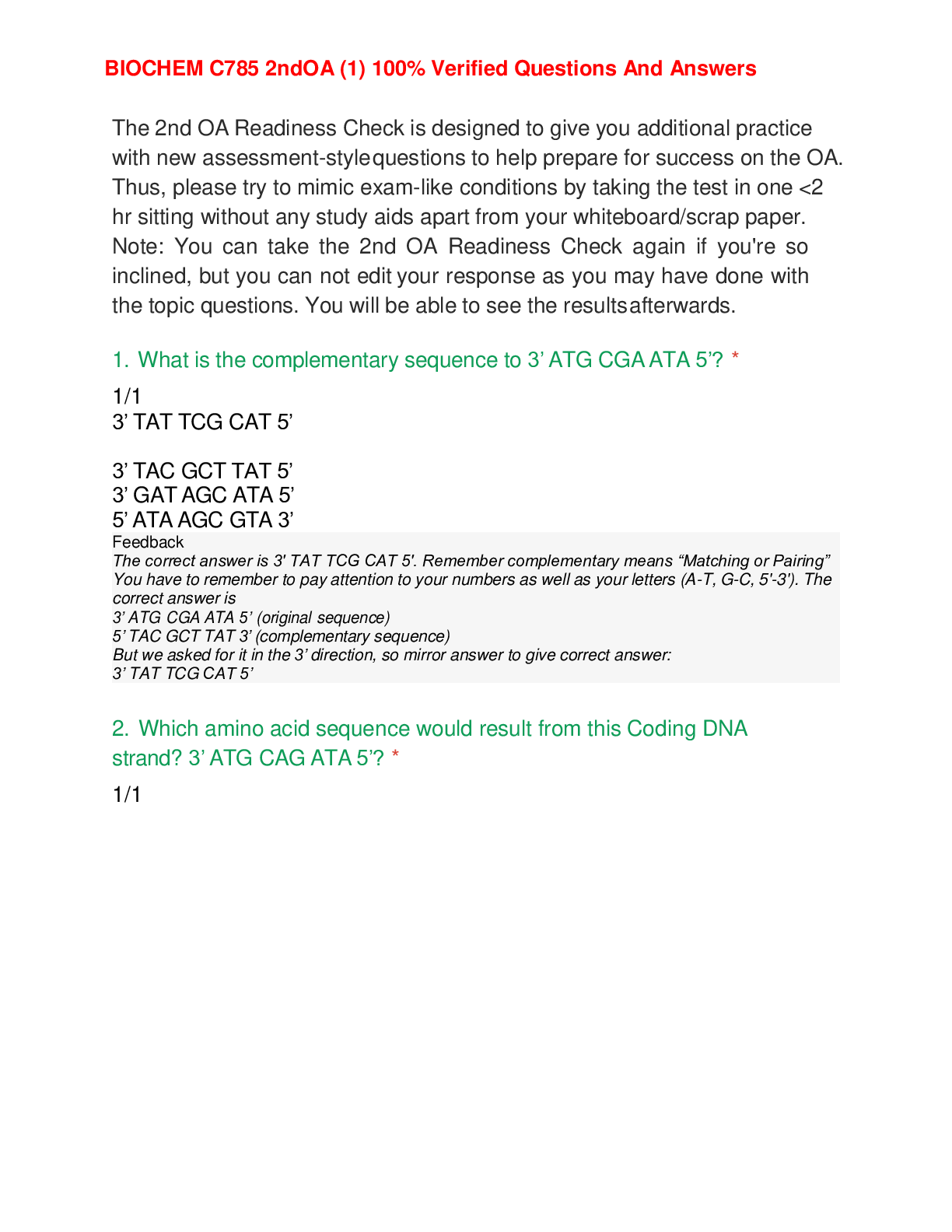
.png)


